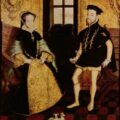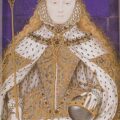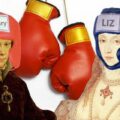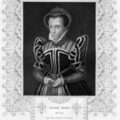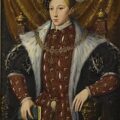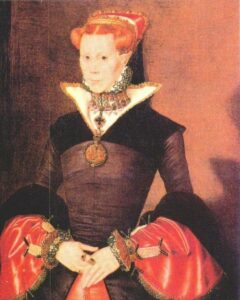
On this day, 457 years after Mary was informed that the Privy Council had proclaimed her Queen Mary I, I’d like to challenge that nickname.
The Myth of Bloody Mary
This title really does get on my nerves. By nicknaming Mary I “Bloody Mary”, we are completely misunderstanding her, maligning her, perpetuating the myths about her and not giving her the credit she deserves for her reign and for paving the way for Elizabeth I’s Golden Age. When I went to the London Dungeon Bloody Mary exhibition webpage, my blood really began to boil as I read the following on Mary I:-
“History:-
Bloody Mary, the deadliest daughter of Henry VIII is ruthlessly ridding the country of heretics.
In her eyes there is only one faith and all those who believe otherwise must be punished. No one is safe from persecution – men, women and children are all suspect in the eyes of Bloody Mary.
Feel the force of her wrath, the heat of the flames and the intensity of Mary’s obsession!”
It goes on to describe what you’ll experience if you visit the exhibition:-
“What you’ll experience
- Watch as Bloody Mary punishes non believers
- Frightening fire
- Punishment and persecution
- Horrid smells
- Hair raising silence”
Hmm…
(banned London Dungeon Bloody Mary advert)
Now, I do have a sense of humour (really I do!) and I’m all up for a bit of fun and for making history accessible and interesting, but I do feel that this gives a very misleading picture of Mary. I am not justifying what she did, she did order the executions of many heretics and it is clear that she was a very damaged woman, BUT compare her reign to her father’s and it is clear to see who really deserves the nickname “Bloody”.
Was Mary “Bloody”?
In an article on The Daily Telegraph website last week entitled Anti-Catholic junk history II: Mary I killed 284, Henry VIII up to 72,000 – but it’s ‘Bloody Mary’ and ‘Bluff King Hal’, Gerald Warner argued that Protestant propaganda has misrepresented history and that the London Dungeon’s promotion of “junk history” regarding Mary I stems from the blackening of Mary’s name in Protestant Elizabethan England. Very true. He goes on to say that according to John Foxe’s “Book of Martyrs”, a Protestant book, Mary I was responsible for the burning of 284 heretics during her reign whereas, according to Holinshed’s Chronicle, Henry VIII was responsible for 72,000 executions, two of them being his wives! Warner also points out that during Edward VI’s reign 5,500 Cornish Catholic rebels were massacred in the Prayer Book Rebellion. So, let’s do some calculations and divide those numbers of deaths by the number of years of their reigns:-
- Henry VIII – 72,000 divided by 37 years (I’m being kind) = 1945.94
- Edward VI – 5,500 divided by 6 years = 916.66
- Mary I – 284 divided by 5 years = 56.8
Now, I know that this doesn’t give us a full picture because Mary’s and Edward’s figures don’t take into account other executions, but I think it is clear that Mary wasn’t quite as bloody as people make out.
Some of you may argue that Mary was “Bloody” because she killed for religious reasons instead of killing rebels, people who challenged her throne, but then you could argue that Mary saw Protestants as traitors, both to England and to God. To understand Mary I, we have to take into account the context of Tudor England, the religious divisions that existed, and Mary’s beliefs. Just like Thomas More before her, she believed that Protestants were heretics and that it was her job as a true believer to rid England of this evil. Linda Porter, in “Mary Tudor: The First Queen”, points out also that many members of the public were not executed on Mary’s orders but were rounded up and burned by their local authorities, a valid point. I’m not justifying what she did, I hate what she did in God’s name, I’m simply trying to understand the woman.
Historical Illiteracy
In Warner’s article, he accuses London Dungeon of “perpetuating anti-Catholic mythology”,which I think is an unfair accusation as I can’t imagine that London Dungeon were aiming to be anti-Catholic in any way, but I do agree with Warner when he says that “the root problem is historical illiteracy”. By perpetuating myths about historical characters we are doing them an injustice and causing people to learn bad history. We have Elizabeth Woodville the witch or Melusina, Richard III the murdering hunchback, Anne Boleyn the six-fingered whore and witch, Catherine Howard the tart… the list goes on and it is time to challenge these labels and stereotypes and teach people proper history, the truth behind the stereotypes and myths.
The Real Mary I
For those of you who want to know more about the real Mary I, I would heartily recommend Linda Porter’s “Mary Tudor: The First Queen” which I reviewed at http://reviews.theanneboleynfiles.com/mary-tudor-the-first-queen-by-linda-porter/74. Porter’s Mary I is not “Bloody Mary”, but, as the blurb on the back of the book says, “a cultured Renaissance princess, strong-willed and courageous”. Remember, this woman was able to become monarch in a time when females were not meant to rule, she was able to rally troops, challenge Lady Jane Grey and win the crown, and she squashed rebellions successfully during her five year reign. Let’s stop calling her “Bloody Mary” and let’s not make the mistake of seeing her as a pathetic puppet of her husband, Philip of Spain, but instead we should give her credit for her achievements:-
“Her bravery put her on the throne and kept her there, so that when she died she was able to bequeath to Elizabeth a precious legacy that is often overlooked: she had demonstrated that a woman could rule in her own right.” Linda Porter, Mary Tudor: The First Queen.
In a BBC History Magazine article, David Loades lists Mary I’s achievements as:-
- Mary I preserved the Tudor succession
- She strengthened the position of Parliament by using it for her religious settlement
- She established the “gender free” authority of the crown
- She restored and strengthened the administrative structure of the church
- She maintained the navy and reformed the militia
He concludes that “Parliament, the revenues, the navy, even the church benefited from her policies. But the big beneficiary was also the least grateful – Elizabeth. Without her sister’s enlightened legislation and sound administration she would have had a much harder time.”
Mary I’s Struggle for the Throne
You can find out more about Mary I’s struggle for the throne in July 1553 in a wonderful series of posts at littlemisssunnydale’s blog “Mary Tudor: Renaissance Queen”, starting with Monday 3 July 1553: Mary Must Act
Notes and Sources
- Mary Tudor: The First Queen byLinda Porter
- “Anti-Catholic junk history II: Mary I killed 284, Henry VIII up to 72,000 – but it’s ‘Bloody Mary’ and ‘Bluff King Hal'” by Gerald Warner
- The Bloody Queen by David Loades – BBC History Magazine, March 2006
- London Dungeon website
